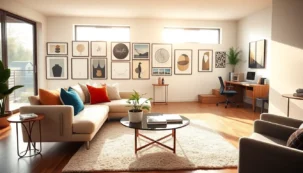
Memory as a Design Tool
Interior design is no longer just about color schemes or furniture placement—it’s about memory. As the digital nostalgia economy grows, more people are reaching backward to design forward, using decor to re-create emotional landmarks from their childhood and teenage years. Among the most surprising trends to emerge in this space is the return of early-2000s style—once dismissed as kitsch, now rebranded as comforting.
What once felt disposable now feels permanent. Think lava lamps, beaded curtains, inflatable chairs, fuzzy rugs, translucent plastics, CD towers, and brushed aluminum. These elements are reappearing not ironically but as genuine expressions of self-curated comfort in a chaotic present. The Y2K aesthetic is no longer confined to TikTok filters—it’s moving into living rooms, bedrooms, and even professional design portfolios.
Teen Bedrooms Become Adult Statements
One of the key drivers behind this shift is a desire to reinhabit the cultural settings of one’s youth. For many millennials and Gen Z adults, that means transforming their homes into stylized versions of their teenage bedrooms—complete with glow-in-the-dark stars, posters of pop icons, and pixelated tech gadgets. What was once a shrine to identity exploration is now a carefully designed anchor of familiarity.
But this is not about mere replication. Designers are now mixing nostalgia with maturity—layering chunky CRT-style monitors with sleek LED lighting, or pairing vinyl bean bags with custom-made modular shelving. It’s about creating hybrid interiors that evoke early digital life while functioning for adult realities.
The Material Language of Sentiment
Y2K interiors speak in materials: the rubbery gloss of a desktop phone, the acrylic sparkle of a pencil case, the chrome finish of a stereo system. Today’s decorators are harnessing this tactile vocabulary to create immersive emotional environments. The goal isn’t minimalism—it’s sensory richness.
These textures aren’t just about aesthetics—they’re about activation. The shine of silver plastic or the warmth of neon pink velour isn’t just a visual cue; it’s a psychological trigger. Designers are intentionally deploying these surfaces to evoke a sense of time travel, tapping into feelings of early internet optimism and wide-eyed pop culture enthusiasm.
Read also: The Quiet Boom of Digital Nostalgia Economies
Marketplace Meets Memory Lane
The commercial side of this revival is booming. Online marketplaces are flooded with secondhand electronics, retro wall art, discontinued IKEA pieces, and collectible Y2K-era accessories. Resale prices on certain items—like the original iMac G3 or Sony’s Dream Machine alarm clock—have surged.
Major retailers have taken note, reissuing capsule collections of early-2000s furnishings and accessories. Even some home brands are launching limited-edition lines inspired by TV shows like Lizzie McGuire, Friends, or Powerpuff Girls, targeting consumers who grew up on those visual languages.

Interestingly, this consumer behavior mirrors user engagement trends on platforms entirely unrelated to decor. Even digital ecosystems built for Football Predictions and sports analysis have leaned into nostalgia-driven UX updates, using retro graphics or throwback interfaces to heighten user sentiment.
Lighting the Past with Modern Tech
While the look is retro, the technology behind these interiors is unmistakably modern. Smart LED bulbs now mimic the glow of lava lamps. Bluetooth speakers come encased in faux-90s boombox designs. Wall-mounted TVs are skinned with colorful frames to resemble old cathode-ray sets.
This fusion of modern function and retro form is what makes the Y2K revival more than cosplay. It’s about merging memory with functionality—creating homes that not only feel like the past, but also serve the needs of the present. Aesthetic memory becomes infrastructure.
Design as Resistance to the Hyper-Efficient
Y2K interiors are cluttered, textured, and emotionally loud—the antithesis of the hyper-efficient, monochrome smart homes popularized over the past decade. In this way, the movement doubles as a subtle resistance. Against the backdrop of rising automation and algorithmic curation, the Y2K revival celebrates the analog, the personal, the goofy.
Designers report that clients are increasingly asking for “mood rooms” rather than “mood boards”—emotional capsules filled with tactile triggers, layered colors, and overstated patterns. The goal is not sophistication but saturation. For a generation raised on overstimulation, a quiet beige living room doesn’t calm—it alienates.
The Next Chapter: Regional Revivals
Interestingly, this nostalgia movement is not monolithic. While the global aesthetic of Y2K style draws heavily from Western media, regional reinterpretations are beginning to emerge. In South Asia, for example, designers are blending retro Bollywood poster art with Y2K lighting schemes. In Latin America, vintage tiled flooring is paired with jelly-finished furniture.
These variations reveal an important truth: nostalgia is not just about a time—it’s about place. As more designers embrace this layered logic, we’re likely to see micro-trends develop based on regionally specific memories, tied to local TV networks, fashion stores, or family rituals.
A Future Built from the Familiar
At its core, the Y2K decor revival isn’t a rejection of the new—it’s a recalibration of comfort. As people seek to build homes that reflect not only their tastes but their timelines, design becomes autobiographical. It tells the story of where someone has been—not just geographically, but emotionally.
In an era where memory itself has become a currency—traded through playlists, Instagram filters, and throwback branding—it’s no surprise that interior design has joined the economy of nostalgia. What’s remarkable is how tactile, expressive, and real that nostalgia has become when it takes physical form.












